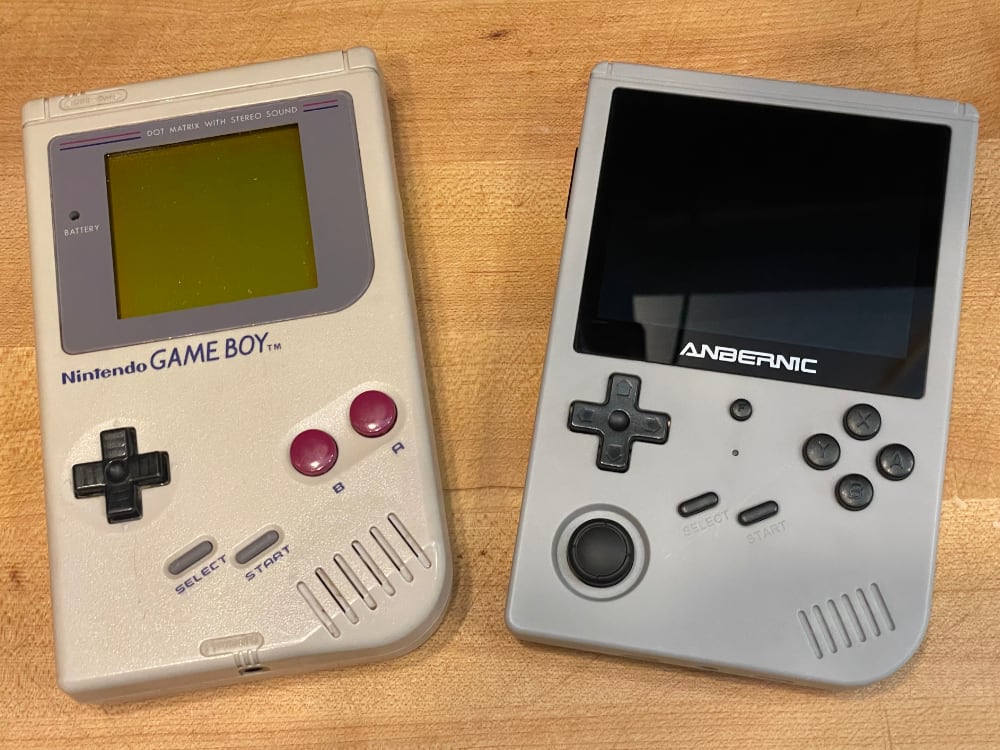Anbernic's RG351v is a retro emulation handheld for players who are nostalgic about the original Nintendo Game Boy. That is such an obvious introduction that it almost feels a little ridiculous to start off with. You can't always judge a book by its cover, but in the case of this particular handheld, you can actually learn almost everything you need to know at face value.
First of all, it's an Anbernic device. That much is clear from the very prominent logo on the display's bezel. Being an Anbernic device, we can thankfully count on a certain level of build quality for this handheld. Anbernic doesn't always push the limits with its product designs or internal specs, but it has a good track record at this point for creating solid, well built handhelds with excellent feeling controls.
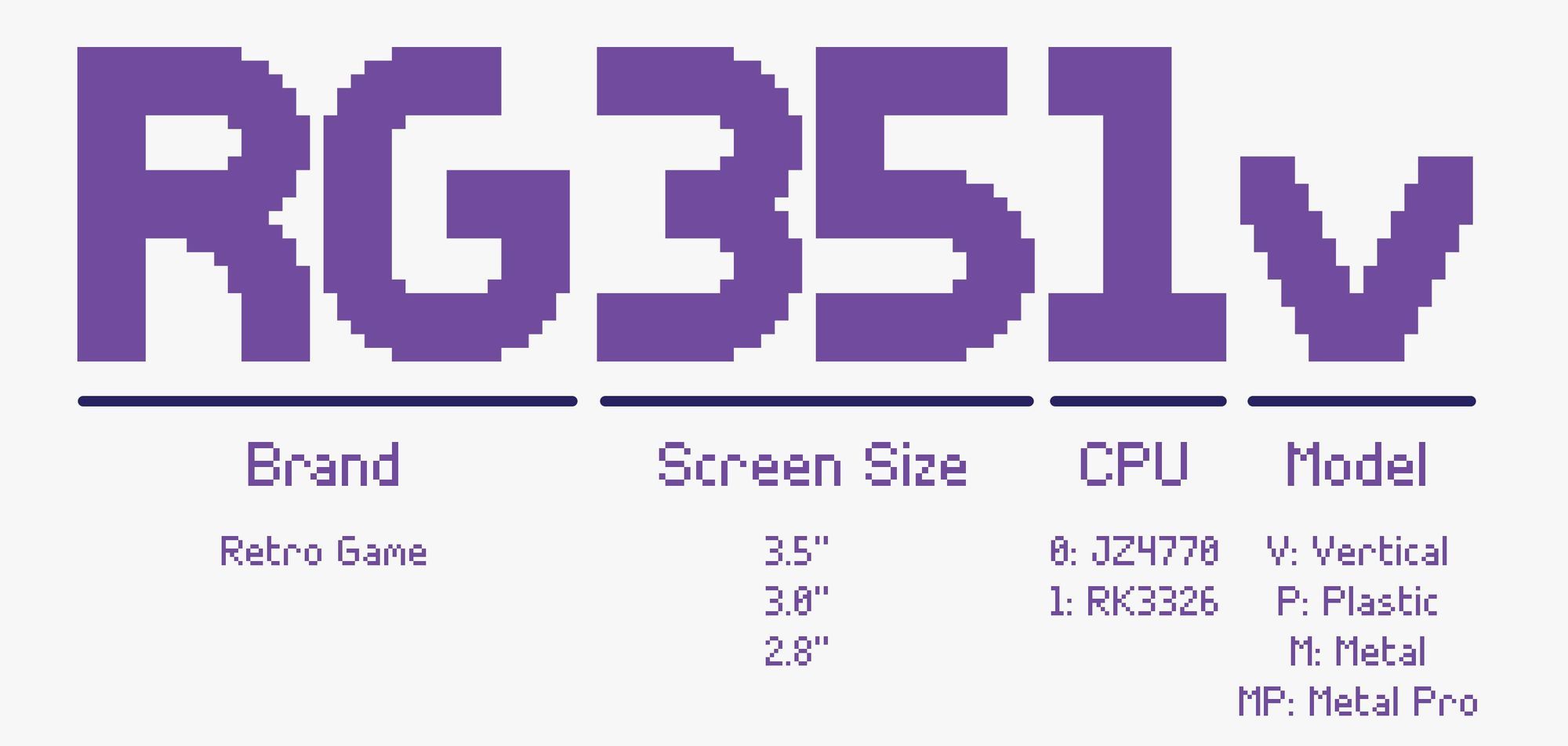
Anbernic follows a somewhat consistent naming scheme for their products, so there's a few more things we can pick up about this particular Retro Game handheld. It's product name starts off with 35, cluing us into the fact that this handheld has a 3.5" screen. The 1 in the name indicates that it's using their second generation of handheld processors since they started counting back with the RG350 line. Not to burst any bubbles, but we're once again dealing with another RK3326 device. Finally there's the "v" at the end. The RG351p was for their plastic horizontal handheld, the RG351m was for their metal horizontal handheld, and the RG351v is their first vertical handheld for this series.
Looking a bit deeper, one can see that the RG351v is sporting a screen with a 4:3 aspect ratio. This is the same nearly-square aspect ratio that TV-based home consoles used until the advent of widescreen HDTVs. Using a 4:3 screen means that you won't have black bars around the edge of the screen for a large swath the games the system's capable of emulating. It's a popular choice for retro handhelds (such as the recently reviewed Retroid Pocket 2), but it was notably absent in devices running the capable RK3326 chip. Previous RK3326 devices such as the Anbernic RG351p, the Powkiddy RGB10, and the ODROID GO Advance all used a 3:2 aspect ratio screen. The 3:2 aspect ratio is great for emulating Game Boy Advance games, but it had black bars on most other platforms, and was a controversial choice for much of the retro handheld community. The RG351v was a welcome addition to the RK3326 lineup, and while there are now a few more options for 4:3 RK3326 handhelds, the RG351v remains one of the more prominent offerings.
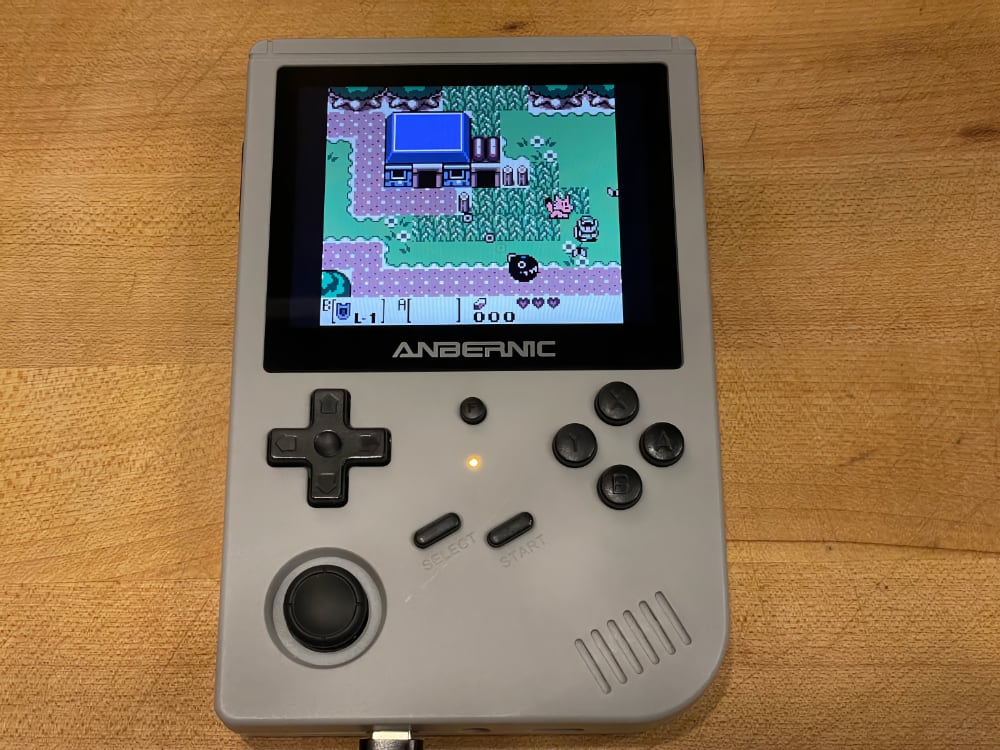
Finally, there's the most obvious aspect. The RG351v is the latest in a long line of handhelds that really want to get you nostalgic about the original Nintendo Game Boy. And who can blame them, right? The Game Boy was the best selling handheld of all time until Nintendo went and outdid themselves with the Nintendo DS. The blocky gray "DMG-01" design remains a head turning classic to this day. It speaks to a simpler time when one could spend their entire afternoon stacking blocks, rescuing princesses, or trading monochrome monsters.
Curiously enough for such a classic design, handheld manufacturers have largely abandoned the vertical formfactor for serious flagship handhelds. Nintendo pivoted from vertical to horizontal with the transition from the Game Boy Color to the Game Boy Advance. After a brief vertical stint with the Game Boy Advance SP, they've never looked back. Meanwhile their largest competitors have never attempted a vertical handheld. Both Sega and Sony's handhelds have been horizontal from the jump, leaving us with the NEC TurboExpress as the most prominent mainstream effort to borrow the original Game Boy's formfactor and orientation.
In the emulation handheld space, vertical handheld attempts have been similarly relegated to side projects and experiments. Efforts such as the GKD Mini, PowKiddy's RGB20, and Anbernic's own RG280v have put out fine devices, but they largely failed to capture the imagination of the retro handheld scene. More often than not, a Game Boy-inspired formfactor is used as a nostalgic lure to attract interest and potential customers. The charitable version of this phenomenon is the devices like the Arduino-based Arduboy and Panic's upcoming Playdate handheld using classic Game Boy influences to bring attention to their diminutive gaming platforms. The more cynical version of this is the mountain of low-cost "NES-on-a-Chip" handhelds that have flooded the market for years. These handhelds generally just use the Game Boy formfactor to package their cheap goods in a familiar appearance. But hey, at least they're doubling as handy battery packs now.
A few serious vertical attempts have been made in the past. On the DIY front, the DMG-01 shell has been a longtime favorite of Raspberry Pi-based Game Boy Zero projects. Anbernic's RG300 and the original Retroid Pocket were also decent options for folks yearning for a Game Boy throwback, but they were generally let down by underperforming internals. The upcoming Analogue Pocket proves that there continues to be interest in this particular formfactor, but it's unfortunately been mired in production delays. The RG351v is the first attempt we've had in a long while of a serious, flagship effort to make a vertical handheld. Let's see if this device is worth your while, or if the formfactor was abandoned for a reason.
The Anbernic RG351v can be purchased on Anbernic's official Aliexpress storefront for approximately $120 USD. It can also be found on Amazon through a variety of 3rd party vendors for the same $120 USD price with faster Prime shipping.
The Hardware
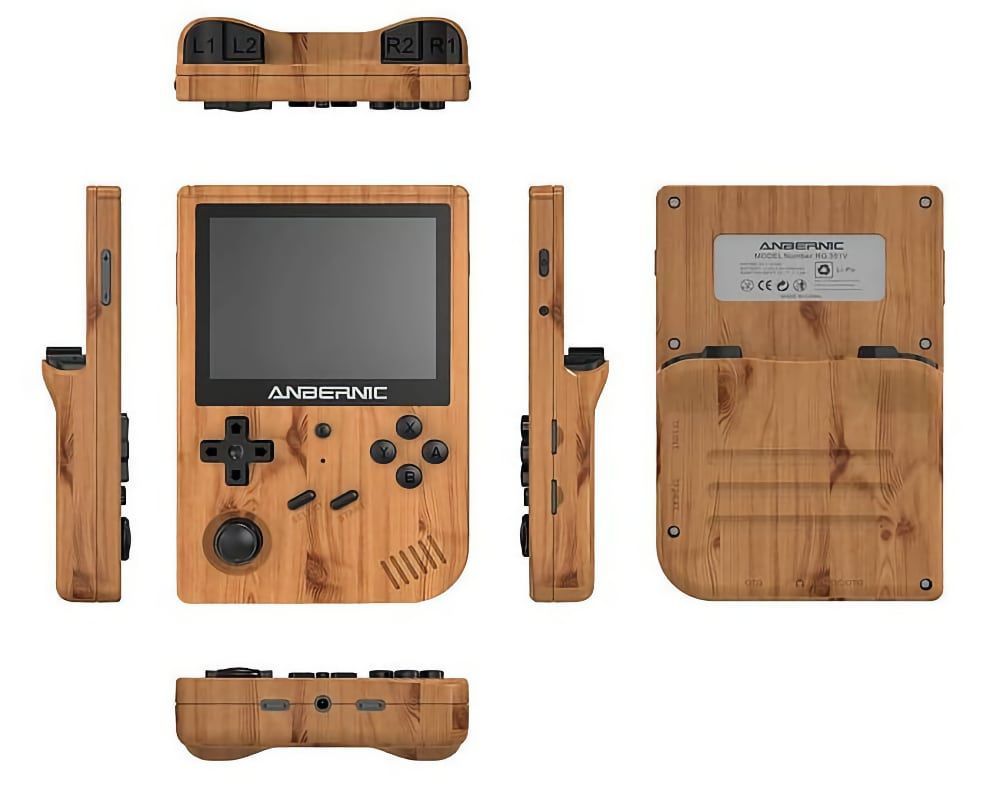
Under the hood, the RG351v doesn't offer up many surprises. It's once again another RK3326 handheld, with a few tweaked connectivity and port options from its RG351p sibling. It has an identical 1.3 GHz Cortex-A35 Quad Core CPU as the RG351p, which can once again be overclocked to around 1.5 GHz. The GPU is the same 650 MHz Mali-G31 MP2 GPU, and its 1 GB of RAM has also gone unchanged. The RG351v is not going to be setting any new records from a performance perspective.
It's 3900 mAh battery packs a few more milliamps than previous devices, helping players get a bit closer to the 6 hour mark of it's 5-6 hour battery life. It eschews the original Game Boy's toggle power switch for a standard power and reset button, and it sadly trades the RG351p's throwback volume wheel for a more standard set of Vol+ and Vol- buttons. New this time around is a "Function" button, which can be mapped to a few hotkeys such as adjusting the screen brightness. The device's power LED and battery indicator is front and center on the handheld, but thankfully has been dimmed enough as to not be distracting during gaming. Depending on your firmware, you can set the LED to be either green or red during standard play.
When it comes to connectivity, the RG351v has a familiar dual USB-C setup. One of these ports is used solely for charging, while the other is a USB-C OTG port that can be used to connect the RG351v to various accessories. Unlike the RG351p, the RG351v has two Micro SD ports. This allows users to store the OS on a relatively smaller 16 GB Micro SD card, and then use the second Micro SD slot for a larger card dedicated to holding all of one's game files. This setup isn't mandatory however, so players can still use a single SD card with an OS and data partition similar to the RG351p. You can use whichever setup you'd like, but if you happen to have a few dual-SD retro handhelds, the second slot makes it easier to move game collections around. Like the RG351m, the RG351v has an onboard 2.4 GHz WiFi chip. Thankfully there is no need for a WiFi dongle here, but the lower Wifi speeds unfortunately mean that streaming apps such as Moonlight and Stadia will once again struggle on this handheld.
The RG351v has a standard 3.5mm headphone jack, and a single mono speaker on the front of the device. Yes, Anbernic chose to retain this aspect of the original Game Boy's design, but don't worry about it. There's more to being a good person than just having a stereo handheld.
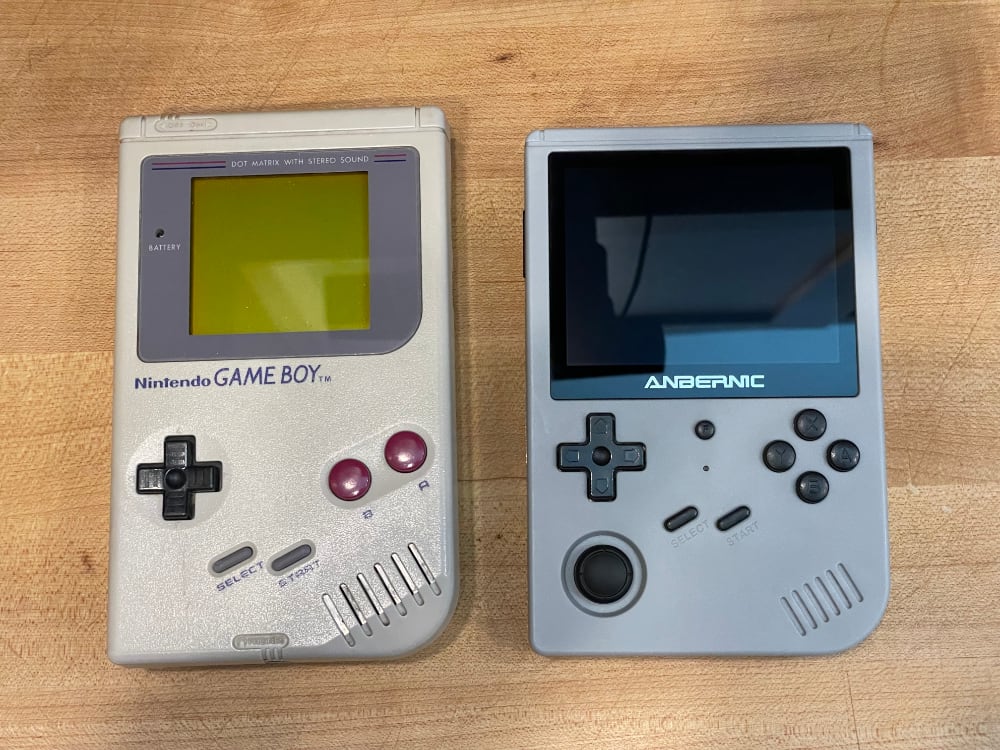
The big differences with the RG351v come with its exterior changes. To start things off, this is a big handheld. Its dimensions are 94mm x 140mm x 26.8mm. For comparisons sake, the RG351p is 151mm x 70mm x 18mm, and the Retroid Pocket 2 is 150mm x 81mm x 17mm. The RG351v is a centimeter shorter on its longest dimensions, but it gains a centimeter or two along the other dimension. Pair that with the added thickness, and it's a noticeably larger device. Since I'm sure you're curious at this point, the original Game Boy is 148mm x 90mm x 32mm. The RG351v is still noticeably thinner, and shaves a few millimeters off in the other dimensions.
When it comes to the controls of the device, Anbernic has shown an interesting balance of opinion and restraint. The front of the RG351v has abandoned quite a few aspects of the original Game Boy design, opting to go with a more SNES-inspired layout. The Game Boy's two slanted buttons have been replaced by the standard face button diamond, and the controls overall are placed much higher up on the handheld than the original unit. The Start and Select buttons are what really give these changes away. Instead of reaching down towards the bottom of the device, these menu options are now smack dab in the middle of the control area.
Anbernic hasn't gone hog-wild here either however. When working with as much space as the Game Boy design has to offer, handheld manufacturers and modders will often take a maximalist approach. Anbernic has only brought one analog stick to this particular party, and they've stuck with the tried and true four-button diamond layout rather than experimenting with a six-button Genesis fight pad configuration. Anbernic clearly know which details matter as well. The speaker grill design and placement has gone completely untouched. Overall the design is reminiscent of Nintendo's historical precedent without slavishly adhering to it.
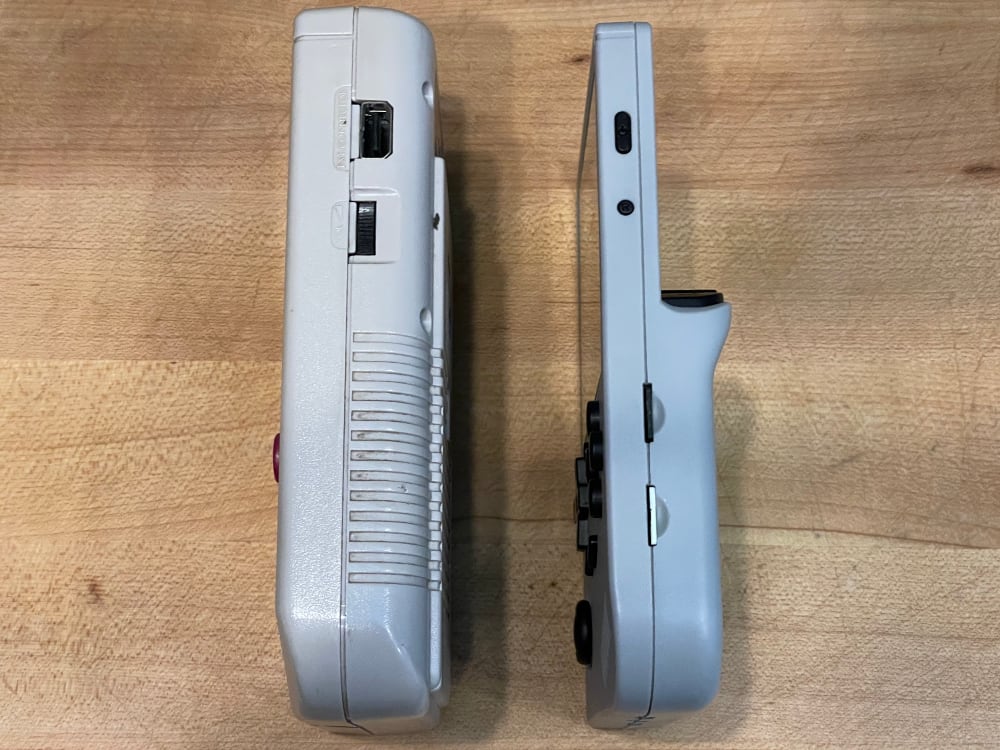
Speaking of historical precedent, Anbernic was largely own their own when it came to the shoulder button design. The Game Boy didn't have any design for them to fall back on, so it was up to them which approach they'd like to take. There's a lot of prior art in this particular field. Raspberry Pi modders have gotten creative with rear-button placements, even going so far as to add four SNES shoulder paddles to the back of the DMG shell. Others have simply added buttons along the side of the device. Powkiddy's RGB20 took the unique approach of creating shoulder button "notches" in the side of their square-shaped handheld. Anbernic does something similar here, creating a shoulder button "shelf" on the back of the device.
When picking up the device, your index fingers naturally fall into the right place. What is a bit unusual is that they've opted for a side-by-side approach on the shoulder buttons. Rather than using two discrete buttons like on the RG351p, the RG351v has two flush buttons with different heights. L1 and R1 sit on the ends of the handheld, while L2 and R2 sit perched a few millimeters above them on the interior of the device. It's a crowded configuration, but one that you can generally feel around and work correctly. There's the occasional misfire, but overall it's a good use of space.
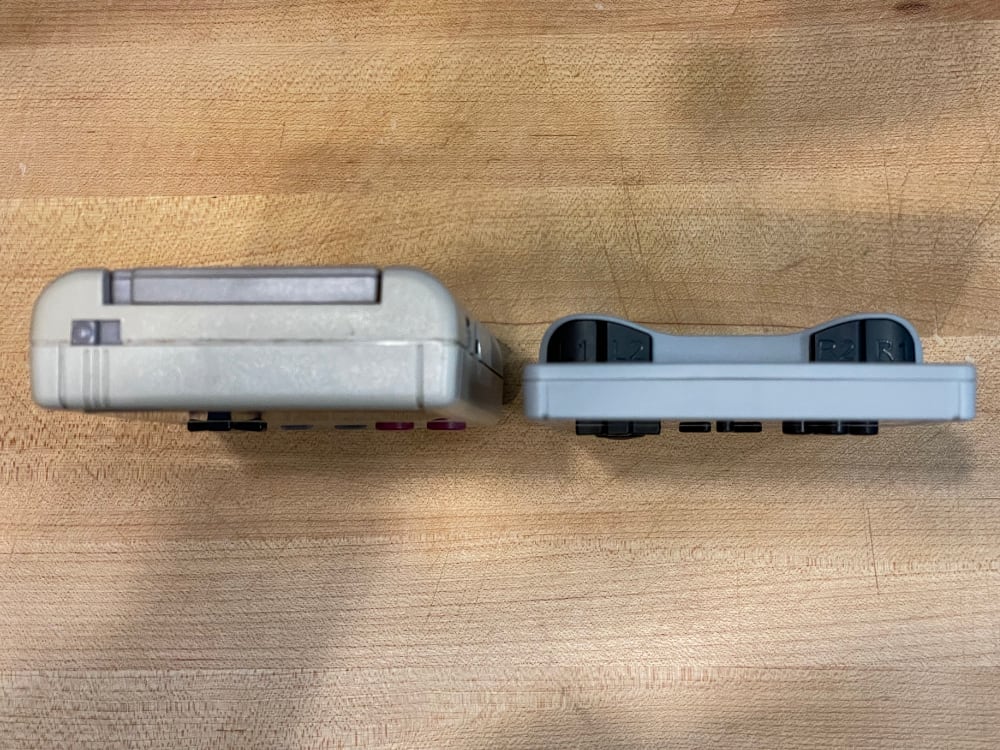
One interesting quirk caused by this shoulder button design is that the RG351v does not have a uniform thickness. The bottom of the device has the familiar chunky Game Boy thickness, but the top is about half as thin. It's only as thick as the screen needs, and oh wow, we haven't talked about the display yet.
The crown jewel of the RG351v is its 640x480 4:3 OCA-laminated IPS display. Like most handhelds of this generation, it features a screen which is 3.5" across, but it feels big on this device. As mentioned before, Anbernic's futzed with the proportions of the Game Boy's design, and so most of the margins around the screen have been removed in favor of more space for the display. The bezel's equally small, leaving you with a striking amount of screen real estate.
It's hard to overstate how nice the screen on this handheld is. A large majority of platforms the RG351v can emulate lack any sort of black bars, leaving everything looking nice and sharp. The color depth is nice and warm, and it's got good black levels. It can produce an impressively bright image, and the screen brightness can be quickly adjusted using the RG351v's function button. When people talk about what they like about this device, it's no surprise that the screen is usually the first thing they mention.
Overall, Anbernic has made some great choices with his handheld. They've certainly made a conscious effort to stray from Nintendo's stylings in a few places, but the design choices Anbernic has made work well here. It's an opinionated handheld without devolving into The Homer of gaming devices.
The RG351v is available in a classic gray, a modern transparent black, and an unusual wood grain pattern. There's a good amount of modding potential for the RG351v as well. Vendors such as Sakura RetroModding has a suite of products to spruce up your blank gray canvas. You can cover Anbernic's device information sticker with classic game cartridge art, or swap the black buttons for SNES or PSX style controls.
The Ergonomics
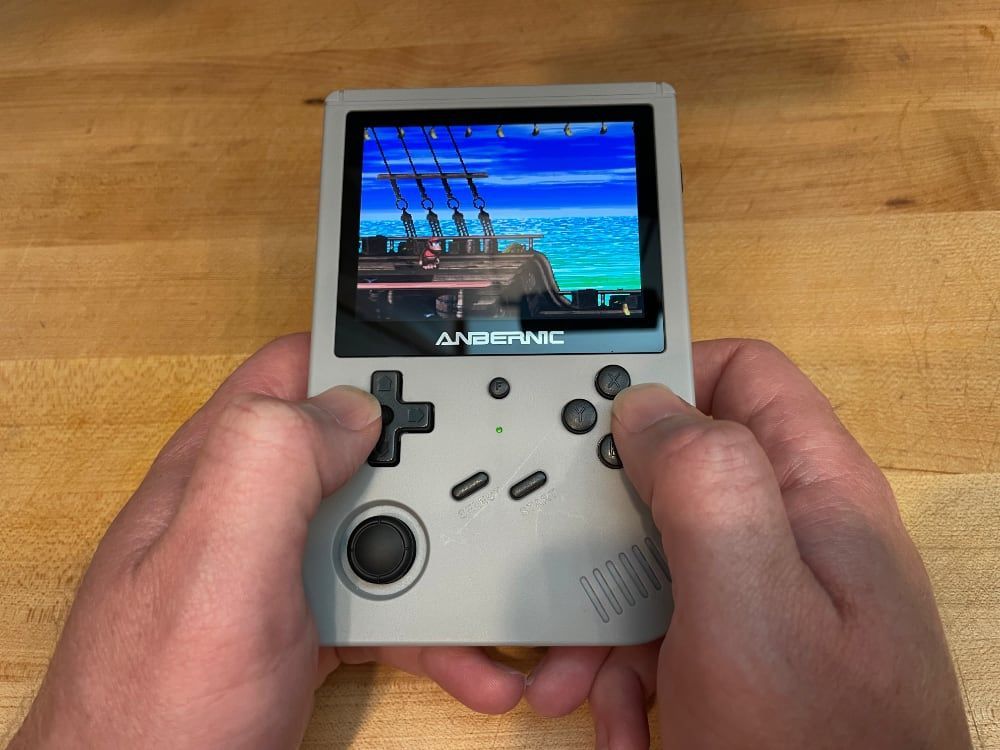
The RG351v has a problem, and that problem is the RG351p. The RG351v and the RG351p have nearly identical internal components and emulation performance, so when comparing these devices, everything comes down to their external characteristics. As we previously covered, the RG351p is a great feeling handheld with an occasionally awkward 3:2 screen. Unfortunately, the RG351v is a handheld with a gorgeous 4:3 screen, and occasionally awkward ergonomics.
That isn't to say that the RG351v feels bad to hold per se, it's just that the RG351p made such a strong showing with its horizontal outing. The RG351p has similar ergonomics to an SNES controller, and has a build quality that rivals Nintendo's first party handhelds. The RG351v has a similar level of build quality, but it can sometimes be a little awkward to hold.
When you first pick up the device, it's not immediately apparent what all your fingers should be doing on the back of the handheld. Your index fingers naturally rest on the shoulder buttons, but where are the rest of them supposed to go? Should you interlace them? Put one hand over the other? Eventually you'll usually settles into a good spot (the curves on the back of the device do a good job of guiding your middle and ring fingers into a comfortable position), but it's an awkward first impression.

The controls themselves are a bit closer together than most people are probably used to. It's a similar but less exaggerated experience of something like the 8-Bitdo Zero mini controller. Full size controllers and horizontal handhelds give your hands a bit of breathing room, but due to the nature of the Game Boy layout, they need to be close together on the RG351v. Thankfully the membrane-based d-pad and buttons feel great, and are up to Anbernic's usual par.
Ergonomics are of course a topic of personal preference. Players with larger or smaller hands may have a difference experience, but it's cited enough in reviews that it's worth noting here. Personally, the RG351v did not leave my hands noticeably sore even after extended play sessions. It wasn't as comfortable for action-heavy titles however. If I had the choice of playing Mega Man X on the RG351p or the RG351v, I'd generally stick with the RG351p. More methodical titles such as RPGs shine on the RG351v however.
What Can It Play?
| Fully Playable |
|---|
| Nintendo Entertainment System |
| Super Nintendo Entertainment System |
| Nintendo Game Boy, Color, & Advance |
| Nintendo Virtual Boy |
| Sega Master System |
| Sega Genesis / Mega Drive |
| Sega CD & Sega 32X |
| Neo Geo Pocket & Color |
| Sony PlayStation |
| Somewhat Playable |
|---|
| Nintendo 64 |
| Nintendo DS |
| Sega Dreamcast |
| Sony PlayStation Portable |
| Not A Change |
|---|
| Sega Saturn |
| Nintendo 3DS |
This section will sound familiar to anyone who's read the recent RG351p or Retroid Pocket 2 reviews. The RG351v is not blazing any new trails here, and continues to trend of solid PlayStation performance, and decent Dreamcast, PlayStation Portable, and Nintendo 64 performance with a subset certain titles. The adjacent table runs down some of the more popular systems, and a full list of supported platforms be found on 351Elec's supported systems page.
The RG351v should be able to handle any 8-bit or 16-bit 2D system you can throw at it. Even the more difficult to emulate SNES games such as Yoshi's Island run with flying colors. All of the TV-based home consoles look great, with their 4:3 image not needing to compromise with any black bars.
Classic Game Boy and Game Boy Color games naturally run well on the RG351v. Their handhelds took advantage of an unusual 10:9 aspect ratio, which is fairly close to 4:3. If you choose to run games at their native aspect ratio, there will be small black bars on the right and left of the screen, but the difference is so minimal that many owners just choose to stretch out the image.
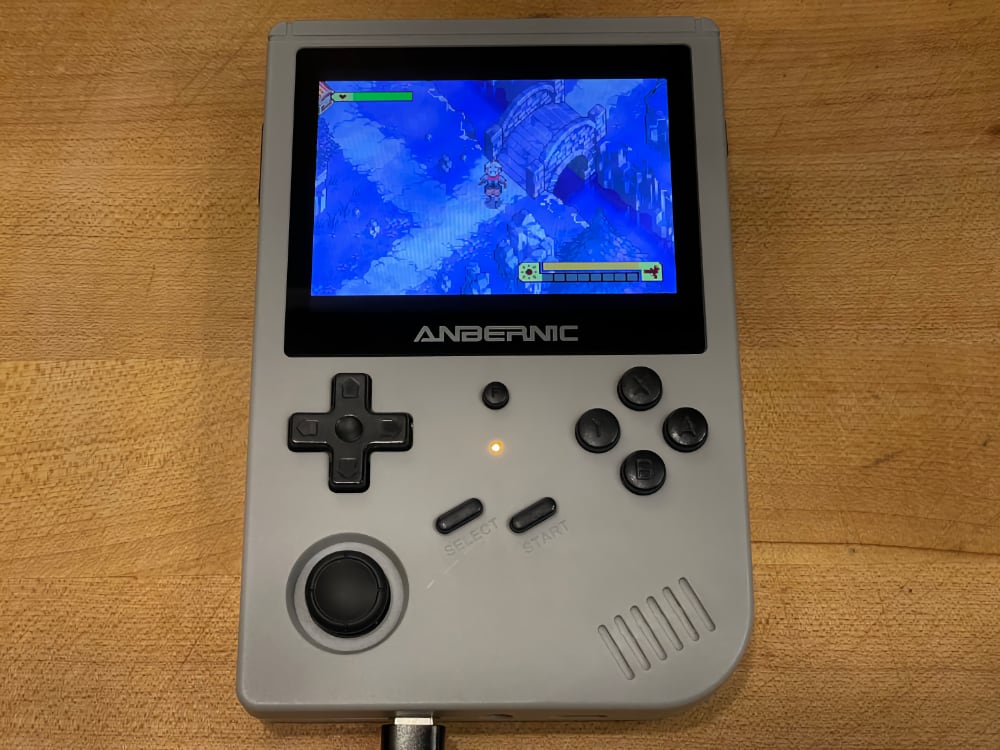
Game Boy Advance games are in a slightly more awkward position. The GBA's 240 x 160 pixel screen doesn't scale evenly with the RG351v's 640 x 480 display. This can lead to a slightly "squished" look on some titles, but thankfully the RG351v's display is pixel dense enough that any scaling artifacts aren't too drastic. There's also some small black bars on the top and bottom of the screen, but you'll generally forget they're there by the time you've gotten your starter in Pokémon Emerald. Playing the occasional GBA game on the RG351v is certainly doable, but GBA enthusiasts may want to take a look at the no black bar, perfectly scaled 480 x 320 RG351p.

PlayStation 1 games look incredible on the RG351's 4:3 display, and they run flawlessly. The lack of a right stick may disappoint some Ape Escape fans, but otherwise this handheld is a solid choice for some PSX nostalgia. The PlayStation Portable has a more rough time, with many titles needing custom frame skip tweaks, and others not running at all. To top it off, the PSP's 16:9 aspect ratio fares the worst on the RG351v. If PSP titles are your gaming priority, it still may make sense to pick up a used PSP or PS Vita until the next generation of retro handhelds come around.
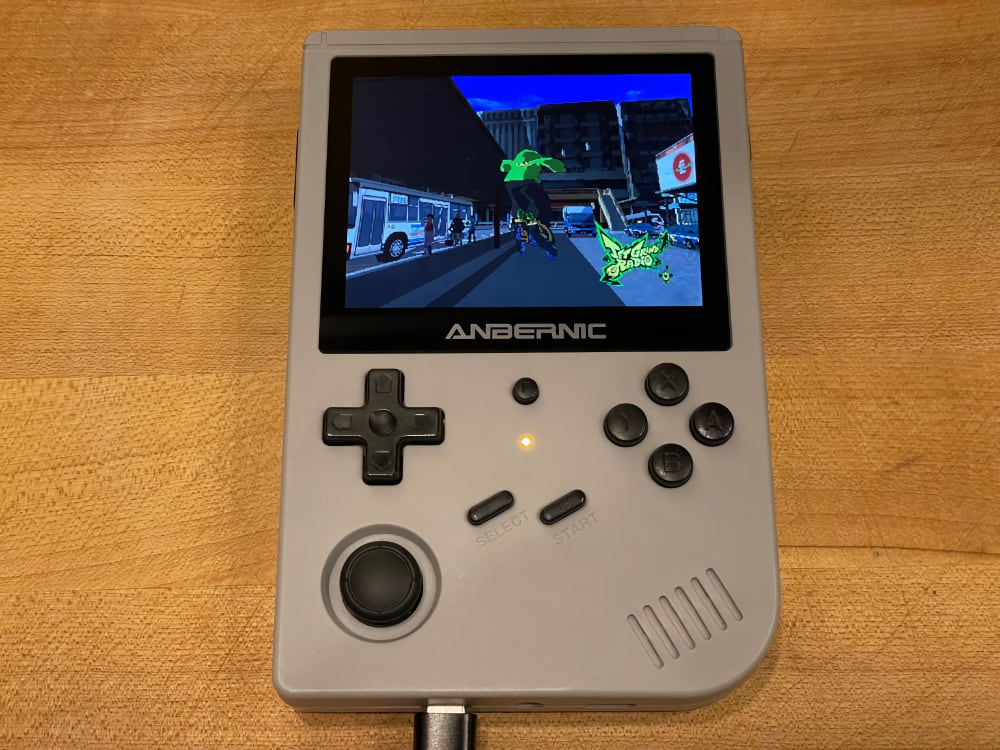
Dreamcast titles also look good on the RG351v, but they push the limits of what the RK3326 chip is capable of. It's titles are generally hit-or-miss, with Jet Set Radio being emulated fast enough for an enjoyable experience, but the Sonic Adventures having enough audio stutters and slowdowns as to generally not make it worth your while. The working Dreamcast titles are fun bonuses to the RG351v's catalog, but it shouldn't be the primary reason you pick up this handheld.
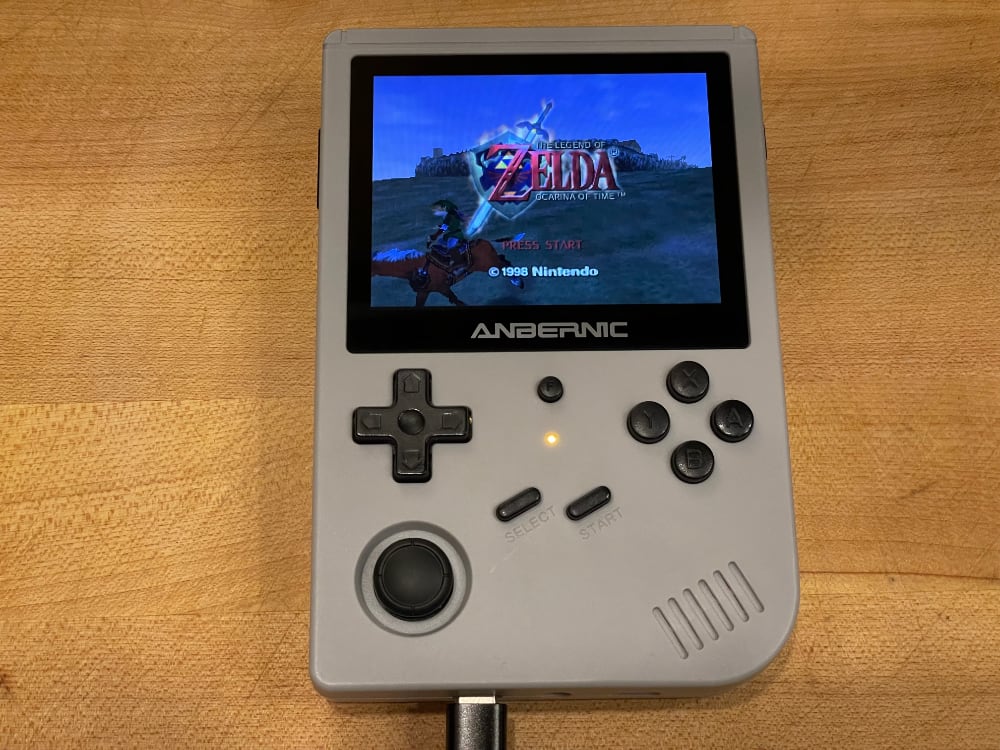
Nintendo's 3D offerings are also a mixed bag. The Nintendo 64 has always proven difficult to emulate, and there are a lot of edge case titles on the RG351v which don't run at a playable speed. Thankfully the community of custom firmware developers have been pushing the limits of N64 performance on these devices, and things have been getting incrementally better over time. The RG351v is a great device to dip your toe back into Wave Race 64, but probably won't be running Perfect Dark anytime soon. On the DS side of things, games actually run somewhat better. The RG351v can run a surprising number of games near their proper speed, but some accommodations need to be made for the lack of a dual screen or touch input. Games which generally only use one screen such as Mario Kart 7 or Phoenix Wright are fun experiences on the RG351v, but anything which relies heavily on touch or needs constant references to the top and bottom half may leave players disappointed.

Outside of emulation, there's a surprising number of games that can run natively on the RG351v. The handheld runs a slimmed down Linux operating system, and while Linux isn't a bastion of gaming (yet), there's a good number of titles on offer. Most of these games were ported to Linux from other platforms, so these non-emulated native apps are collectively known as "Ports" by the community.
A surprising number of these Ports are commercial games with legitimate Linux releases. Titles like Undertale and Shovel Knight can be downloaded off of Steam and finagled onto the RG351v without too much drama. Likewise, a number of indie games and fan games have Linux versions which run well on the RG351v. If you haven't gotten a chance to check out Cave Story or Sonic Robo Blast 2, picking up one of these handhelds is a good excuse to give them a try. There's also a number of 90s first person shooters which have been ported to the RG351 devices, but unfortunately you most likely won't be playing anything past Doom with the RG351v's single analog stick.
These Ports aren't a replacement for full Android Play Store access, but they're a nice bonus to the RK3326 ecosystem. Installing a Port usually involves copying over a launcher script and game asset files, but there's also a community installer that holds streamline the process. PortMaster has helped fill the gap left by the demise of the Anberports project, and already is showing strong support by the community.
Firmware Options
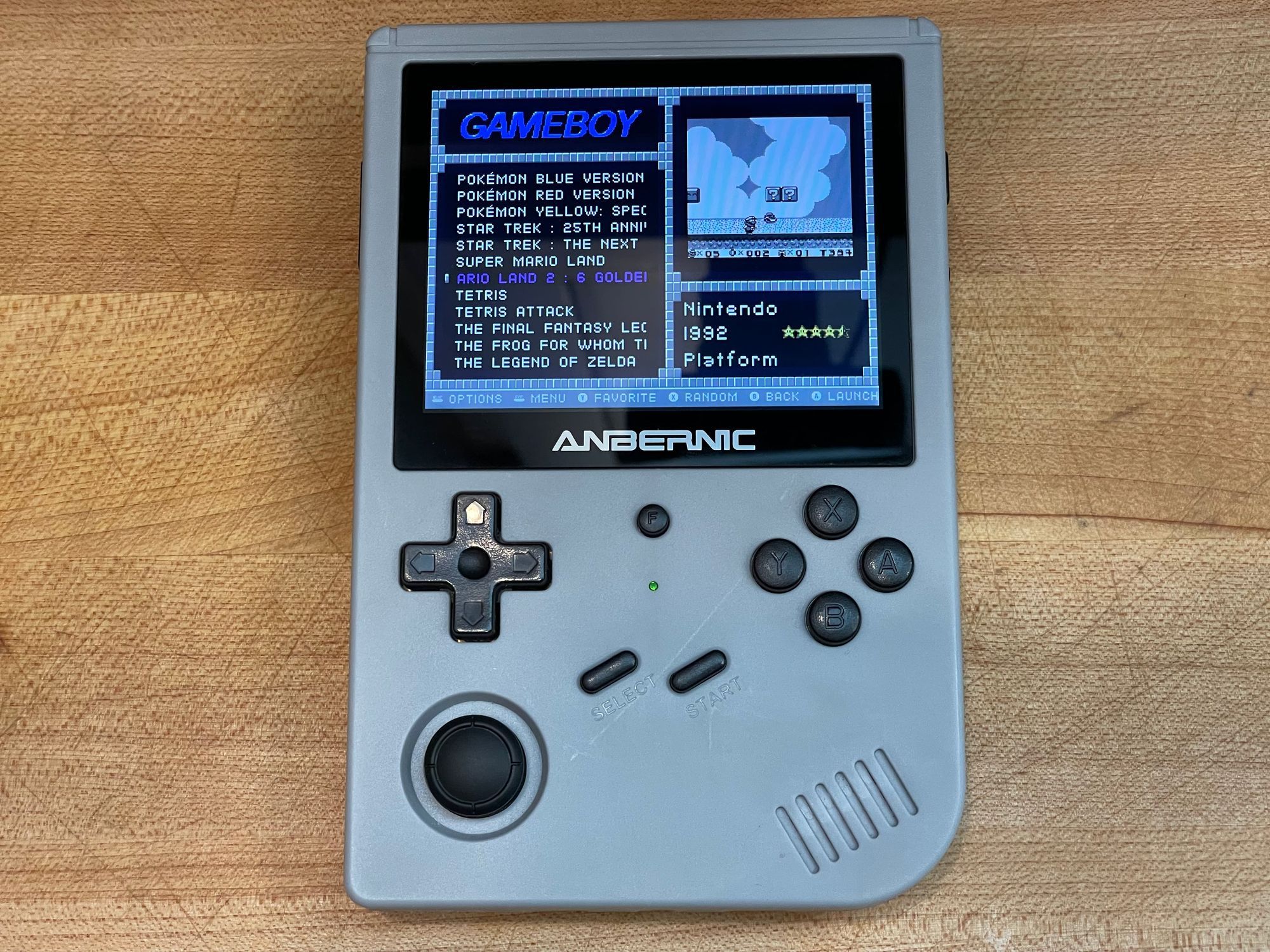
The RG351v has largely the same firmware offerings as the RG351p. Once again, the stock firmware is a custom version of EmuElec. This Linux-based firmware combines a variety of open source emulators, frontends, and tools, which users of the Retro Pie Raspberry Pi image may already have a passing familiarity with. To help organize and launch games, EmuElec takes advantage of the Emulation Station frontend. The vast majority of EmuElec's emulators are based off of RetroArch and its "Cores" system.
The out-of-the-box EmuElec experience is surprisingly solid, so if you're not a very technical user, you can stick with that and have a great time with your RG351v. If you're technical enough to write a disk image to an SD card however, there's a few great community firmwares out there that you should give a try.
351Elec and ArkOS are the two largest community firmwares for the RG351v. There's also a few newer firmwares such as Retro Arena and RetroOZ. The firmwares generally take advantage of the existing Emulation Station and RetroArch stack of technologies, but update and optimize the experience to get every last ounce of performance out of the handheld.
Development on the RG351p was starting to wind down for a variety of reasons. These custom firmwares are incredibly mature at this point, and most of their large goals has been accomplished. The RG351p also had some under the hood technical issues which developers were getting tired of working around. Thankfully the RG351v does not have some of these issues, and with it being a newer device, it's still seeing support from both the 351Elec and ArkOS projects.
When picking an OS, it's hard to go wrong. 351Elec takes a philosophy of having "smart defaults". Emulators on the handheld are pre-configured with their optimal settings, letting players immediately jump into their games. ArkOS on the other hand is a blank-slate, kitchen sink approach. There's a myriad of options for one to customize in order to create their personal, perfect RG351 experience.
For the more adventurous RG351p owners out there, the 351Droid project is pushing the limits of what the RK3326 handhelds can do. Instead of running Linux, 351Droid introduces the LineageOS Android distribution to the RG351v. It's still in its early stages, and you'll need a USB-C OTG adapter with a mouse and keyboard for some of tasks, but the dev team recently cracked the nut on wifi support, and is working to polish the firmware for a full release.
Let's Talk About Nostalgia
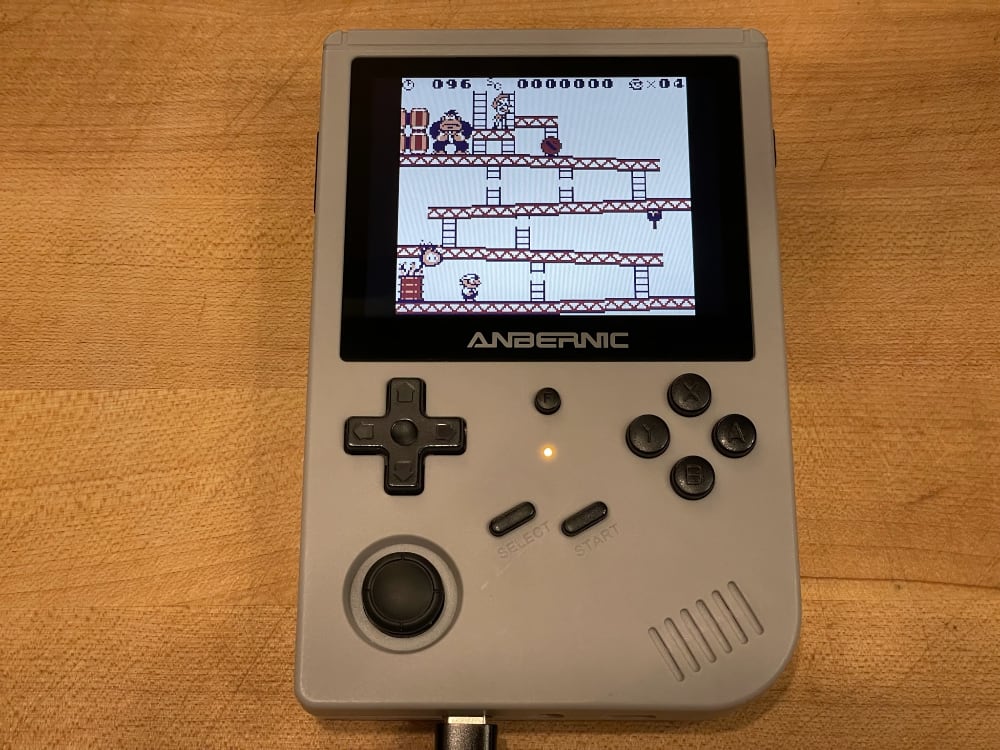
Discussing tech specs is a great way of knowing what a device is capable of, but it doesn't always give you a clear idea of what using a particular gadget is like. As someone who grew up experiencing Nintendo's full Game Boy lineup, it's hard to express how much the RG351v scratches and itch I didn't even know I had.
I've continually referenced the RG351p in this review because on paper, it's a nearly identical device as the RG351v. During my time with the RG351p, I experienced all that it was capable of. I'd lean into GBA titles a bit more often, but I enjoyed it's SNES capabilities, it's PSX support, I conquered some DC titles, and played with community Ports. The most neglected portion however was the Game Boy and Game Boy color sections.
The RG351p runs Game Boy games fine of course. I went back and tried the For the Frog the Bell Tolls translation without any issues, and thoroughly enjoyed the experience. It was just a system that, given everything else the device can do, I never dabbled with it much.
The RG351v has been the complete opposite experience. When I was initially testing the handheld, I fired up Donkey Kong (94, GB) to make sure everything was working properly. I ended up sitting down and playing the game for an hour straight. This hasn't been an isolated incident either. The Game Boy Color Metal Gear Solid game has always been on my backlog, but I could never seem to get invested enough in the title when I made earlier efforts to play it. Firing it up on the RG351v immediately got me hooked.
Playing Game Boy games on this handheld just feels right, in a way that is hard to quantify on a spec sheet. My primary concern was that the SNES-style face buttons wouldn't quite match up with the slanted GB-style face buttons, but that hasn't been an issue at all. It feels a bit foolish to say that this $100+ USD device is what one needs to pick up if they want to indulge in some serious Game Boy nostalgia, but here we are. After reviewing this device, Analogue's indulgent $200 USD Pocket FPGA handheld makes a lot more sense.
Incidentally, this handheld also makes a solid JRPG machine. SquareSoft's PlayStation-era RPGs look stunning on this device's 4:3 display. Grinding for spell draws in Final Fantasy VIII must have enough in common with trolling Viridian Forest for a Pikachu that it feels natural to curl up with this handheld on a sofa and conquer a multi-disc odyssey.
Conclusion

Anbernic's RG351v is a great handheld. It accomplished everything it set out to do, brought 4:3 RK3326 gaming to the world, and proved that there's still a place for premium vertical handheld experiences. That being said, it's a somewhat tricky handheld to actually recommend. It's not immediately clear who the RG351v is for. That question is all the more confused by the recent arrival of the RG351mp, which uses the same screen as the RG351v. (We hope to have a review up of that particular handheld in the coming weeks.)
If price is your concern, the RG351p is twenty dollars cheaper. If ergonomics are your top priority, the RG351p and RG351mp still have it beat. If you want the most portable option, again, the RG351v is the largest of the bunch. The RG351v used to have its 4:3 screen as its claim to fame, but now there's the GameForce Chi and RG351mp to consider.
At the end of the day, the RG351v is the perfect device for people who like the look of the RG351v. If it's the handheld you point to when looking at the current lineup of devices, you'll probably have a great time with it. It may not be most people's first retro handheld, but if you're starting to get into the collector mindset, it's a great second retro handheld. There's not much out there like it, and it's throwback design makes it a fun curio that will continue to have a place in people's collections even after more powerful Android devices come out.
Delicious:
- The Game Boy inspired design will resonate perfectly with a certain subset of players.
- The 4:3 screen is one of the nicest looking displays currently available, and is well suited for most of the platforms the RG351v can emulate.
- Onboard WiFi makes downloading new metadata a breeze.
- Easy setup & firmware upgrades.
Suspicious:
- Awkward ergonomics.
- No HDMI out.
- N64, Dreamcast, and PSP performance is less than ideal.
- Ports more limited than Android app stores.
Verdict:
- The RG351v belongs in any die-hard Game Boy fan's collection, but there may be better options with regard to price and ergonomics if someone's looking for their first retro handheld.
*The RG351v featured in this review was purchased by the reviewer.
